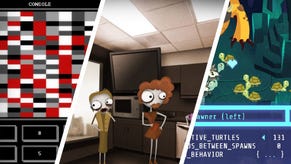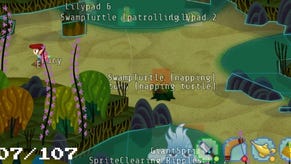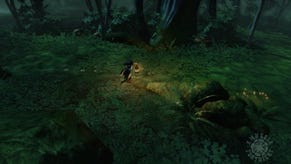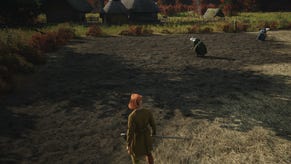Impressions: Hack 'N' Slash
Early Hacksess
The first thing that happens in Hack 'N' Slash is the player is given a weapon, a sword, and then it breaks. Beneath the sword's external stabby part is a USB interface. A smarter person would point out how this is a microcosm of the game, because you solve puzzles by peeling away the game's outer layer to manipulate the code beneath the surface. Me? I'll just lazily use it as a way of introducing the concept and then hop into the game proper. Oh, and I'll also say it's great.
I was a bit worried about Hack 'N' Slash. I am not someone who has the patience to work out connections in the world of code. I'm going to attempt to improve that with Codecademy, but for now I still look at programming the way a cat looks at an air balloon. I prefer to stab things and slam my mouse, but with the pointed end of the sword broken I was forced to follow the rules. It's a Zelda-influenced wander-a-thon, strikingly similar if you look at the character while squinting. Except hacking at things with the sword opens up a dialogue box where the object's gamestate resides.
To begin with, you only need to worry about [true] and [false] choices that unlocks doors. I'm usually an impatient and angry person in tutorials, but in Hack 'N' Slash the slow and easy nature of the puzzles led me merrily along. I wasn't coding, and to be fair you won't really be fully coding (just toggling states and selecting new input settings), but in time the decisions became looser, and enabled me to experiment sooner than I imagined.
One of those decisions was because of a turtle. The game's bound together with the sort of whimsy that Double Fine are incredibly at ease with, so the world is a fantasy setting where you'll be coding the rage out of turtles, or tweaking the locks in a prison door by warping down into the lock itself and inspecting the components. I stood in front of the angry critter and goaded him into charging at me. I dodged, he hit a wall and flipped, and on his tummy was a USB slot. Swinging at the turtle brings up a box full of information. Here. Look.
Look at what you can do! It's all explanatory as well. The context here required that I change EXPLODE_ON_CHARGE_HIT from 'false' to 'true' so the turtle exploded a block blocking my passage. It's an immediate introduction to the broad range of capabilities that are exposed in some of the creatures. The innocuous looking 'IDLE_BEHAVIOR' is the probably most powerful tool. With it you can change the movement parameters of the creatures, defining new patrol patterns. If you're smart, you could set off a turtle (or in later levels, a guard) patrolling around the level. You can tell it when to pause, when to turn, how far to walk, and who to attack, and with a set-plan that one helpful enemy can wipe out all the others.
It's also possible to set the damage level into negative figures, so when I'm attacked it heals me, which saves me hacking bushes to spit out hearts. You are overpowered, but it's more fun figuring out your own boundaries than it would be if the game imposed them on you. This isn't about the strength of the power you wield, but how you can come to understand your ability's effects and use them.
Progression brings a series of upgrades: there's a boomerang that you can use to code objects that are far away; there's a hat (and a scroll that takes it place) that enables you to see the elements that make up a level--vision cones, invisible moving platforms, item IDs--so you can figure out larger puzzles; and there's a loupe that creates little physical levels out of the code, basically shrinking you down and sticking you in the circuits. There's others, but they're not used as much as those three.
The challenges are a lovely blend of fantasy obstacles with logical solutions: I brute forced a password thanks to a sheet of paper that gave me a few letters. I knew one of the words, and the rest I just typed out till I had it. Another puzzle had a fairy singing in the same tone as a 56k modem,
and it was scaring away some turtles. I needed the turtles in place to cross a pond, so you reprogram the fairy's singing voice to zero. It's absolutely absurd and wonderful. Even the dialogue trees are fun.
I did get stuck at the glyphs, though. There's a puzzle involving a square of glyphs and a piano off to the side. It's the sort of thing that always keeps me from progressing in games. With enough time I can just about work out mathmagics, but I suck at iconography and had to hunt a solution online. It was a strange puzzle because until then, and with everything following, I was mostly able to figure things out, but the square of glyphs told me nothing. In fact, if there's a problem with the game in its current state it's that it probably needs to explain things just a bit more. The friendly Sprite that follows you does spit out helpful advice, but in this case I was left hanging.
It's also brought over the frustrating elements of Zelda. It's easy to get lost - there's a fast-travel that allows you to move through time, which is good if, like I did, you forget to do a puzzle, but it means you've undone all the work after that if you want to carry on in that timeline. It's basically a save game, which is an odd way to do things. I've also had to wander to and fro to figure out where to go next, which I hate. Games shouldn't be about stumbling about in the dark. It's also so early that there's no hint of a menu and I've no idea how to quit the game without Alt-Tabbing and killing it in Task Manager. It's crashed solidly at least twice. But I still managed to carry on without much trouble, to be honest. The crashes have only sent me back a screen.
So it's a bit wobbly, but it's also Early Access. Double Fine's fixers have made a small, lovely little game, and I feel slightly smarter having played it.




















